
Epicauta is a genus of beetles in the blister beetle family, Meloidae. The genus was first scientifically described in 1834 by Pierre François Marie Auguste Dejean. Epicauta is distributed nearly worldwide, with species native to all continents except Australia and Antarctica. Surveys have found the genus to be particularly diverse in northern Arizona in the United States. Few species occur in the Arctic, with none farther north than the southern Northwest Territory of Canada.

The Sepidiini is a tribe of ground-dwelling darkling beetles (Tenebrionidae), that occurs across Africa, the Mediterranean Basin, the Arabian Peninsula and Mesopotamia. It is composed of many hundreds of species. The larvae of some species are known to damage crops.

The helmet toktokkies are ground-dwelling, Afrotropical beetles in the family Tenebrionidae.

Psammodes is a genus of ground-dwelling Afrotropical beetles in the family Tenebrionidae. They are black or dark rufous in color and stout in shape, and average about 2.6 cm in body length. Like the related genus Dichtha, the adults tap out a rhythm on the ground to attract and locate mates. Habitats are varied, from coastal forests to ridges and hills, woodland and deserts.
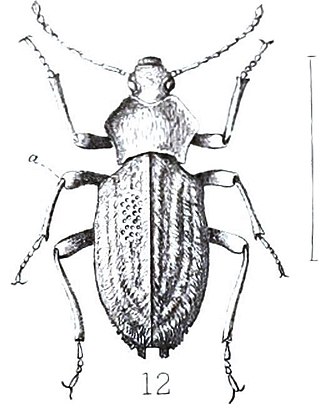
Hypomelus is a genus of beetles of the family Tenebrionidae. It is the type genus of the Hypomelina subtribe.

Asidini is a tribe of darkling beetles in the subfamily Pimeliinae of the family Tenebrionidae. There are more than 30 genera in Asidini.

Hypomelina is a subtribe of darkling beetles in the family Tenebrionidae. There are about 9 genera and more than 40 described species in Hypomelina, found mainly in southern Africa. The majority of species were described from the Namibian coast, and only the genus Bombocnodulus is found as far north as central Africa.
Oxurina is a subtribe of darkling beetles in the family Tenebrionidae. There are about 8 genera and more than 50 described species in Oxurina, found in southern and central Africa.
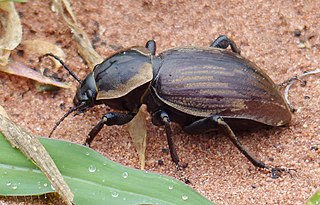
Phanerotomeina is a subtribe of darkling beetles in the family Tenebrionidae. There are about 5 genera and more than 150 described species in Phanerotomeina, found mainly in the southern part of the Afrotropics. Only two species were described north of the equator.
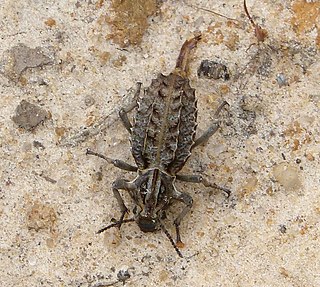
Sepidiina is a subtribe of darkling beetles in the family Tenebrionidae. There are about 8 genera and more than 110 described species in Sepidiina, found widely distributed in the Mediterranean area and Sub-Saharan Africa. Most species were described from the Horn of Africa.

Trachynotina is a subtribe of darkling beetles in the family Tenebrionidae. There are about 10 genera and more than 170 described species in Trachynotina, found in southern Africa. Although Sepidiini species attract the attention of enthusiasts due to their outstanding morphology and behaviour, the group lacks comprehensive revisions at all taxonomic levels.
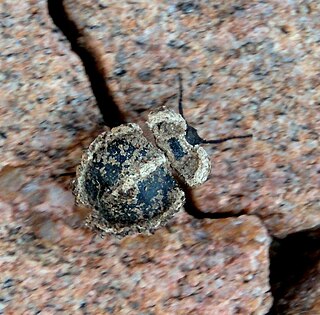
Adelostomini is a tribe of darkling beetles in the subfamily Pimeliinae of the family Tenebrionidae. There are more than 30 genera in Adelostomini, found primarily in tropical Africa.
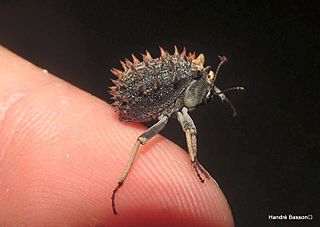
Cryptochilini is a tribe of darkling beetles in the subfamily Pimeliinae of the family Tenebrionidae. There are about 11 genera in Cryptochilini, found in tropical Africa.

Tentyriini is a tribe of darkling beetles in the subfamily Pimeliinae of the family Tenebrionidae. There are more than 90 genera in Tentyriini.
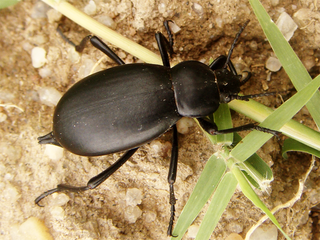
Blaptini is a tribe of darkling beetles in the family Tenebrionidae. There are more than 30 genera in Blaptini.
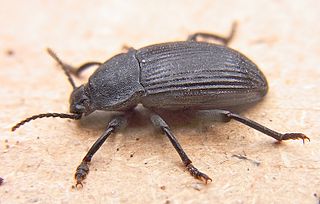
Dendarini is a tribe of darkling beetles in the family Tenebrionidae. There are more than 30 genera in Dendarini.

Pedinini is a tribe of darkling beetles in the family Tenebrionidae. There are about 19 genera in Pedinini.
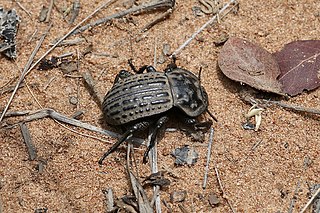
Platynotini is a tribe of darkling beetles in the family Tenebrionidae. There are more than 70 genera in Platynotini.

Platyscelidini is a tribe of darkling beetles in the family Tenebrionidae. There are about eight genera in Platyscelidini.

Mariazofia is a genus of ground-dwelling Afrotropical beetles in the family Tenebrionidae. They are among the largest of the darkling beetles. Like other genera within subtribe Molurina, adults of this genus engage in a behavior known as "substrate tapping", a form of sexual communication in which they produce vibrations by tapping their abdomen rhythmically on the ground to attract mates. Their common name, "tok-tok beetle" or "toktokkie beetle", is based on this behavior.


















